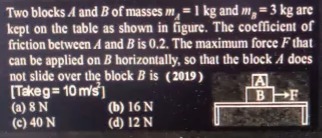Question
Question: Two blocks $A$ and $B$ of masses $m_A = 1$ kg and $m_B = 3$ kg are kept on the table as shown in fig...
Two blocks A and B of masses mA=1 kg and mB=3 kg are kept on the table as shown in figure. The coefficient of friction between A and B is 0.2. The maximum force F that can be applied on B horizontally, so that the block A does not slide over the block B is (2019) [Take g=10m/s2]

A
8 N
B
16 N
C
40 N
D
12 N
Answer
8 N
Explanation
Solution
-
For block A not to slip on block B, its acceleration must not exceed
amax=μg=0.2×10=2m/s2.
-
To accelerate block A at 2m/s2, the friction force required is
f=mAa=1×2=2N.
-
The entire system (blocks A and B) accelerates together. For block B, applying Newton’s second law yields
F−f=mBa.
-
Therefore,
F=mBa+f=3×2+2=6+2=8N.
Thus, the maximum force F that can be applied on block B so that block A does not slide is 8 N.
